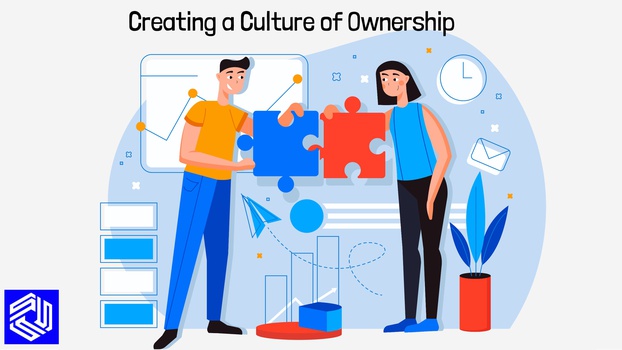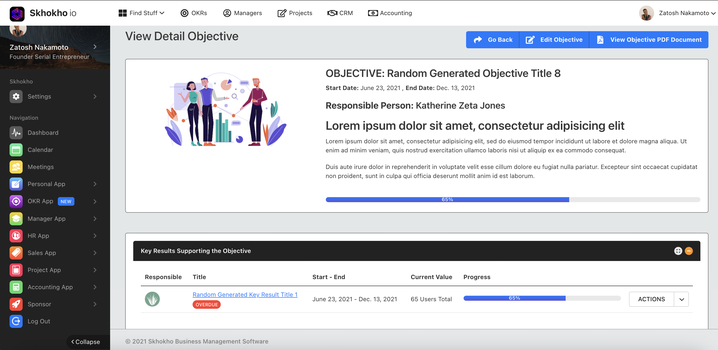Creating a Culture of Ownership: Key Strategies for Fostering Accountability
Organizations are recognizing the vital role of accountability in driving performance, achieving goals, and sustaining success. One powerful way to cultivate accountability within a company is by fostering a culture of ownership. When individuals take ownership of their work and actions, they become more invested in the organization's goals and outcomes.
In this blog post, we will delve into key strategies that can help organizations cultivate a culture of ownership and, consequently, foster accountability. By implementing these strategies, leaders and managers can inspire their teams to embrace ownership, take initiative, and be accountable for their actions and outcomes. Let's explore these strategies in detail and unlock the power of accountability within your organization.

Understanding the Importance of Accountability
Accountability plays a crucial role in driving both individual and organizational success. When individuals and teams are accountable, they take ownership of their responsibilities and strive to meet and exceed expectations. A culture of ownership goes beyond mere responsibility; it encompasses a sense of personal commitment, proactive problem-solving, and a willingness to be held accountable for results. It empowers employees to act as leaders within their roles, making decisions aligned with the organization's vision and values.
By establishing a culture of ownership, organizations can create an environment where every team member feels a deep sense of responsibility and takes pride in their contributions. This, in turn, fosters greater accountability, boosts productivity, enhances collaboration, and drives overall performance.
A culture of ownership significantly contributes to fostering accountability. When individuals feel a sense of ownership, they are naturally motivated to take responsibility for their actions, outcomes, and the overall success of the organization. It promotes a proactive mindset, encourages collaboration, and reinforces a shared commitment to achieving common goals. By establishing a culture of ownership, organizations can create an environment where accountability thrives and drives sustainable success.
Strategy 1: Setting Clear Expectations
One of the fundamental strategies in fostering a culture of ownership and accountability is setting clear expectations for each team member. When roles, responsibilities, and expectations are clearly defined, it creates a solid foundation for individuals to understand their accountability and work towards common goals. Here's why this strategy is crucial and some practical tips for effective communication:
- Importance of Clear Definitions:
- Clarity eliminates confusion: Clear expectations leave no room for ambiguity or misunderstandings. When individuals have a clear understanding of their roles and responsibilities, they can focus on their tasks without uncertainty or guesswork.
- Alignment with organizational goals: Clearly defining expectations ensures that everyone's efforts are aligned with the organization's overall objectives. It provides a roadmap for individuals to contribute meaningfully to the team's success.
- Practical Tips for Effective Communication:
- Develop detailed job descriptions: Begin by creating comprehensive job descriptions that outline the core responsibilities and key deliverables for each role. Clearly articulate the specific tasks, goals, and performance indicators expected from individuals.
- Conduct regular one-on-one meetings: Schedule periodic one-on-one meetings with team members to discuss their roles, responsibilities, and expectations. Use this time to clarify any uncertainties, address questions, and provide feedback on their performance.
- Set SMART goals: Ensure that goals are Specific, Measurable, Achievable, Relevant, and Time-bound (SMART). This framework provides a clear roadmap for individuals to track their progress and assess their accountability.
- Communicate openly and transparently: Foster a culture of open communication where individuals feel comfortable seeking clarity or expressing concerns. Encourage questions and provide timely responses to ensure everyone is on the same page.
- Use visual aids and documentation: Supplement verbal communication with visual aids, such as flowcharts, process diagrams, or visual project timelines. Additionally, document important expectations in written form, such as job manuals or team handbooks, for future reference.
Skhokho OKRs
Skhokho OKR is a performance management software that enables an organization to track and measure progress towards specific objectives. The system is designed to help organisations identify and track objective key results (OKRs), set goals, and track progress over time. Skhokho OKR can be used by businesses of all sizes and across all industries.

Key Features:
- Set High Level Objectives
- Create Supporting Key Results
- Measure Achievements
- Helps a business with sticking to their resolutions
Start by creating a 14 day free account here: https://skhokho.io/authentication/register
By setting clear expectations, you empower individuals to take ownership of their responsibilities and be accountable for their performance. Remember, ongoing communication is key. Regularly revisit expectations, provide constructive feedback, and adapt as circumstances evolve. This strategy lays a strong foundation for a culture of ownership and accountability within your organization.
Strategy 2: Empowering Employees
Empowering employees is a powerful strategy for fostering a culture of ownership and accountability within an organization. By granting individuals autonomy and authority in decision-making processes, organizations can tap into their expertise, creativity, and problem-solving abilities. Here's why empowerment is crucial and how it leads to a sense of ownership and increased accountability:
- Importance of Giving Autonomy and Authority:
- Encourages ownership: When employees have the freedom to make decisions and take ownership of their work, they feel a greater sense of responsibility and commitment. They become more invested in the outcomes and take pride in their contributions.
- Utilizes diverse skills and perspectives: Empowerment allows individuals to leverage their unique skills, knowledge, and perspectives. By involving employees in decision-making processes, organizations tap into a broader range of ideas and expertise, leading to more innovative and effective solutions.
- Enhances job satisfaction and motivation: When employees feel trusted and empowered, their job satisfaction and motivation increase. They are more engaged, proactive, and willing to go the extra mile to achieve success.
- Empowerment Leads to a Sense of Ownership and Increased Accountability:
- Encourages proactive problem-solving: Empowered employees are more likely to proactively identify and address challenges. They take initiative to find solutions and make informed decisions, leading to improved problem-solving capabilities within the organization.
- Drives personal investment in outcomes: When employees have a say in decision-making processes, they develop a personal investment in the outcomes. They feel accountable for the results because they actively participated in shaping them.
- Builds trust and collaboration: Empowerment fosters a culture of trust, where employees feel trusted and valued. This trust leads to increased collaboration, as individuals work together towards shared goals, supporting one another in their accountable actions.
- Enhances learning and growth: When employees have the freedom to make decisions, they learn from both successes and failures. They develop their skills, gain confidence, and become more adaptable and resilient, contributing to a culture of continuous learning and growth.

Strategy 3: Encouraging Open Communication
Open and transparent communication is a critical strategy for fostering accountability within an organization. When communication channels are open and individuals feel comfortable expressing their thoughts and concerns, it creates an environment of trust and collaboration. Here's why open communication is vital and some strategies for creating a safe space for honest feedback and discussion:
- Role of Open Communication in Fostering Accountability:
- Builds trust: Open communication fosters trust among team members and between employees and leaders. When people feel that their voices are heard and respected, they are more likely to take ownership and be accountable for their actions.
- Enhances understanding: Clear and open communication ensures that everyone has a shared understanding of expectations, goals, and challenges. It minimizes misunderstandings and enables individuals to align their efforts towards common objectives.
- Encourages learning and growth: Through open communication, individuals can provide constructive feedback, share insights, and learn from one another. This exchange of ideas promotes continuous learning, growth, and improvement.
- Identifies and addresses issues promptly: Open communication allows problems and concerns to be brought to light promptly. By addressing issues early on, organizations can prevent them from escalating and negatively impacting accountability.
- Strategies for Creating a Safe Space for Honest Feedback and Discussion:
- Foster a culture of psychological safety: Create an environment where individuals feel safe to express their thoughts, ideas, and concerns without fear of judgment or retribution. Encourage inclusivity, active listening, and respect for diverse perspectives.
- Lead by example: Leaders should model open communication by being approachable, receptive to feedback, and transparent in their own communications. When leaders demonstrate openness, it sets the tone for others to follow suit.
- Implement feedback mechanisms: Establish formal and informal channels for feedback, such as regular performance discussions, anonymous suggestion boxes, or team retrospectives. Encourage two-way communication and ensure feedback is acted upon.
- Encourage constructive dialogue: Promote respectful and constructive dialogue among team members. Encourage active participation, active listening, and the sharing of diverse viewpoints. Encourage individuals to challenge ideas respectfully and provide constructive criticism.
- Provide communication training: Offer communication skills training to employees to enhance their ability to express themselves effectively, actively listen, and provide feedback in a constructive manner.
Strategy 4: Leading by Example
Leadership plays a crucial role in fostering a culture of accountability within an organization. Leaders have the power to set the tone, influence behavior, and inspire their teams to embrace accountability. By modeling accountability behaviors themselves, leaders can create a ripple effect, motivating others to follow suit. Here's why leadership by example is essential and some examples of how leaders can demonstrate accountability:
- Critical Role of Leadership in Modeling Accountability Behaviors:
- Sets expectations: Leaders have the responsibility to clearly define expectations, communicate goals, and outline the importance of accountability to their teams. By setting high standards and leading by example, leaders send a powerful message that accountability is a core value within the organization.
- Establishes trust: When leaders consistently demonstrate accountability, they build trust among their team members. Trust is the foundation for a strong culture of accountability, as individuals feel confident that their leader will hold them accountable and lead with integrity.
- Inspires others: Employees look up to their leaders for guidance and inspiration. When leaders exhibit accountability behaviors, they inspire their teams to follow suit. This creates a positive domino effect, where individuals take ownership, act responsibly, and hold themselves and others accountable.
- Examples of How Leaders Can Demonstrate Accountability:
- Taking responsibility: Leaders should take responsibility for their own actions, decisions, and mistakes. When they admit their errors and actively seek solutions, it sets a powerful example of accountability for others to emulate.
- Honoring commitments: Leaders should consistently deliver on their commitments and meet deadlines. By keeping their promises, they demonstrate reliability and create a culture where accountability is valued.
- Seeking feedback: Leaders should actively seek feedback from their team members, acknowledging that they are not infallible. By soliciting input, listening attentively, and acting upon feedback, leaders show humility and a willingness to learn and grow.
- Providing clear feedback: Leaders should provide timely and constructive feedback to their team members. By offering guidance and holding individuals accountable for their performance, leaders foster a culture of continuous improvement and accountability.
- Encouraging open communication: Leaders should create a safe space for open and transparent communication, where team members feel comfortable sharing their thoughts, concerns, and ideas. By actively listening and valuing diverse perspectives, leaders demonstrate inclusivity and accountability.

Overcoming Challenges
Fostering a culture of ownership and accountability within an organization is not without its challenges. However, with the right strategies and approaches, these challenges can be overcome. Here are some common challenges organizations may face and strategies for addressing them:
- Lack of clarity and alignment:
- Challenge: When roles, responsibilities, and expectations are unclear or not aligned, it becomes difficult to establish accountability.
- Strategy: Clearly define and communicate roles, responsibilities, and expectations to ensure everyone understands their accountability. Regularly revisit and revise these definitions to adapt to evolving needs. Foster open dialogue and encourage questions to address any confusion.
2. Fear of failure and blame:
- Challenge: Fear of failure and a blame-oriented culture can hinder individuals from taking ownership and being accountable.
- Strategy: Create a safe environment where failure is viewed as an opportunity for growth and learning. Encourage individuals to take calculated risks, learn from mistakes, and share lessons learned. Focus on problem-solving rather than assigning blame when things go wrong.
3. Resistance to change:
- Challenge: People may resist changes that come with a shift towards a culture of ownership and accountability.
- Strategy: Communicate the benefits of accountability and ownership, emphasizing how it contributes to individual and organizational success. Involve employees in the change process by soliciting their input, addressing concerns, and providing opportunities for collaboration and feedback.
4. Lack of leadership support:
- Challenge: Without leadership support, it is challenging to establish and sustain a culture of ownership and accountability.
- Strategy: Educate leaders on the importance of accountability and their role in modeling it. Provide leadership development programs that focus on fostering accountability behaviors. Encourage leaders to set clear expectations, provide feedback, and recognize and reward accountability efforts.
5. Inconsistent reinforcement:
- Challenge: Accountability efforts may wane if reinforcement and recognition are inconsistent.
- Strategy: Regularly reinforce and recognize accountable behaviors through formal and informal mechanisms. Implement performance management systems that assess and reward accountability. Celebrate individual and team achievements publicly to reinforce a culture of ownership.
6. Lack of trust and psychological safety:
- Challenge: Without trust and psychological safety, individuals may be hesitant to take ownership and be accountable.
- Strategy: Foster trust through open and transparent communication. Encourage collaboration, active listening, and respectful feedback. Establish norms that promote psychological safety, where individuals feel comfortable expressing their thoughts, concerns, and ideas without fear of judgment.
7. Limited resources for development:
- Challenge: Limited resources, such as time or budget, can hinder employees' ability to invest in their own development and take ownership.
- Strategy: Identify creative solutions to overcome resource constraints, such as leveraging online learning platforms, cross-functional collaboration, or mentorship programs. Prioritize learning and development initiatives and provide employees with dedicated time for growth activities.
Overcoming these challenges requires a combination of clear communication, supportive leadership, continuous reinforcement, and a commitment to creating an environment that fosters accountability. By addressing these challenges head-on, organizations can build a strong culture of ownership and accountability, leading to improved performance, engagement, and success.
Summary
Take the initiative and be the catalyst for change in your organization. Encourage your colleagues and leaders to join you on this journey towards a culture of ownership and accountability. Remember, fostering accountability is a collective effort that requires commitment and persistence. By working together, you can create an environment where accountability thrives, and your organization flourishes.
Skhokho OKR Software
Unlike most OKR software, Skhokho OKR software integrates seamlessly with your Business Management and Administration tools. For example – you can easily create OKRs that you use to track employee performance within their performance management plans that are managed inside of the HRMS application of Skhokho.

These are two different applications that are usually separate – but with integrated tools, you can keep your information in one place. Try our Skhokho with the 14 day no obligation free trial and get to experience Skhokho OKR software for yourself.









